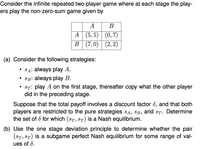
ENGR.ECONOMIC ANALYSIS
14th Edition
ISBN: 9780190931919
Author: NEWNAN
Publisher: Oxford University Press
expand_more
expand_more
format_list_bulleted
Question

Transcribed Image Text:Consider the infinite repeated two-player game where at each stage the play-
ers play the non-zero-sum game given by
A
В
A (5, 5) (0,7)
В (7, 0) | (2, 2)
(a) Consider the following strategies:
SA: always play A.
SB: always play B.
• St: play A on the first stage, thereafter copy what the other player
did in the preceding stage.
Suppose that the total payoff involves a discount factor 8, and that both
players are restricted to the pure strategies SA, SB, and sT. Determine
the set of d for which (ST, ST) is a Nash equilibrium.
(b) Use the one stage deviation principle to determine whether the pair
(ST, ST) is a subgame perfect Nash equilibrium for some range of val-
ues of 8.
Expert Solution
This question has been solved!
Explore an expertly crafted, step-by-step solution for a thorough understanding of key concepts.
This is a popular solution
Trending nowThis is a popular solution!
Step by stepSolved in 2 steps

Knowledge Booster
Learn more about
Need a deep-dive on the concept behind this application? Look no further. Learn more about this topic, economics and related others by exploring similar questions and additional content below.Similar questions
- Please give me correct answer with calculation otherwise i give multiple downvotearrow_forward2. Consider two players playing a simultaneous moves game. These players can be one of the two states of the world, state 1 or state 2, while playing the game. The payoffs-matrix for the two state games are as follows: State 1 P1 U D P2 L R 1,4 1,0 1,6 2,16 0,0 0,24 M State 2 P1 U D P2 L M R 1,0 1,4 1,6 2,16 0,24 0,0 Each players believes that the two states are equally likely, Derive the BNE of the game.arrow_forwardparameter z= 1 In the unique subgame perfect Nash equilibrium, what is the sum of the payoffs tothe two players?arrow_forward
- Consider the game below. How many best responses does Player 1 have to strategy L of Player 2? 1) 0 2)1 3) 2 4)3 Player 1 T M B L 2,0 2, 2 2,3 Player 2 с 2,1 3,2 1, 2 R 3,2 0,1 0,3arrow_forwardPlayer 1 Player 2 2 X 4 2 y 1 3 X 2 2 b y O 6 3 1 4 2 X 1 5 y O Consider the game tree given above: a. Write out the set of pure strategies for all players. b. Find the Subgame Nash equilibria of this game.arrow_forwardQ5 A and B are sharing a room with a TV and a DVD player. DVD's can be rented for the weekend for a cost of $5. They would each get $4 worth of enjoyment from a weekend movie, so if both of them rent a movie a on a particular weekend they can each get $8 worth of enjoyment at a cost of $5 rental. (a) Model this as a strategic form game with both players having the strategies Rent (R) and No Rent (N), (b) What is the equilibrium if they share the room for one weekend only? (e) Draw the extensive form of the game if they stay together for two weeks, and identify the subgame perfect equilibria. (d) Explain whether or not the outcome of the game will change if they stay together for 10 weeks.arrow_forward
- Consider the two-player game depicted below w А 1,5 2,2 0,4 3,11 В 13,0 4,1 2,5 4,2 с 1,3 2,6 5,2 2,0] a. What is Player 2's best response if Player 1 plays B? b. What is Player l's best response if Player 2 plays z? c. What are the pure strategy Nash Equilibria? సాarrow_forwardNonearrow_forwardThis payoff matrix shows a two-player variant of the sushi game, but where B really loves sushi, so her payoffs from getting to eat sushi are higher than A's, and her payoffs from there not being enough sushi are lower than A's. Payoffs are ordered A, B. В A 10, 15 10, 25 20, 15 0, -5 A. Find and state all of the mixed strategy Nash equilibria of the game. If there are multiple equilibria, number them in preparation for answering part "c." B. (From the week 6 lectures) Draw a graph of the expected payoffs for each player. Use these graphs to formulate the decision rule for each player. C. (From the week 6 lectures) Draw a graph of the best replies of the two players. Carefully label each Nash equilibrium.arrow_forward
arrow_back_ios
SEE MORE QUESTIONS
arrow_forward_ios
Recommended textbooks for you

 Principles of Economics (12th Edition)EconomicsISBN:9780134078779Author:Karl E. Case, Ray C. Fair, Sharon E. OsterPublisher:PEARSON
Principles of Economics (12th Edition)EconomicsISBN:9780134078779Author:Karl E. Case, Ray C. Fair, Sharon E. OsterPublisher:PEARSON Engineering Economy (17th Edition)EconomicsISBN:9780134870069Author:William G. Sullivan, Elin M. Wicks, C. Patrick KoellingPublisher:PEARSON
Engineering Economy (17th Edition)EconomicsISBN:9780134870069Author:William G. Sullivan, Elin M. Wicks, C. Patrick KoellingPublisher:PEARSON Principles of Economics (MindTap Course List)EconomicsISBN:9781305585126Author:N. Gregory MankiwPublisher:Cengage Learning
Principles of Economics (MindTap Course List)EconomicsISBN:9781305585126Author:N. Gregory MankiwPublisher:Cengage Learning Managerial Economics: A Problem Solving ApproachEconomicsISBN:9781337106665Author:Luke M. Froeb, Brian T. McCann, Michael R. Ward, Mike ShorPublisher:Cengage Learning
Managerial Economics: A Problem Solving ApproachEconomicsISBN:9781337106665Author:Luke M. Froeb, Brian T. McCann, Michael R. Ward, Mike ShorPublisher:Cengage Learning Managerial Economics & Business Strategy (Mcgraw-...EconomicsISBN:9781259290619Author:Michael Baye, Jeff PrincePublisher:McGraw-Hill Education
Managerial Economics & Business Strategy (Mcgraw-...EconomicsISBN:9781259290619Author:Michael Baye, Jeff PrincePublisher:McGraw-Hill Education


Principles of Economics (12th Edition)
Economics
ISBN:9780134078779
Author:Karl E. Case, Ray C. Fair, Sharon E. Oster
Publisher:PEARSON

Engineering Economy (17th Edition)
Economics
ISBN:9780134870069
Author:William G. Sullivan, Elin M. Wicks, C. Patrick Koelling
Publisher:PEARSON

Principles of Economics (MindTap Course List)
Economics
ISBN:9781305585126
Author:N. Gregory Mankiw
Publisher:Cengage Learning

Managerial Economics: A Problem Solving Approach
Economics
ISBN:9781337106665
Author:Luke M. Froeb, Brian T. McCann, Michael R. Ward, Mike Shor
Publisher:Cengage Learning

Managerial Economics & Business Strategy (Mcgraw-...
Economics
ISBN:9781259290619
Author:Michael Baye, Jeff Prince
Publisher:McGraw-Hill Education